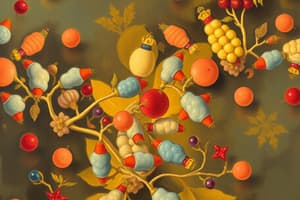Podcast
Questions and Answers
Which of the following is NOT a primary function of proteins in biological systems?
Which of the following is NOT a primary function of proteins in biological systems?
- Storing genetic information (correct)
- Transporting molecules
- Providing structural support
- Catalyzing biochemical reactions
Which level of protein structure is characterized by the overall three-dimensional arrangement of a polypeptide chain?
Which level of protein structure is characterized by the overall three-dimensional arrangement of a polypeptide chain?
- Quaternary structure
- Primary structure
- Tertiary structure (correct)
- Secondary structure
What is the main driving force behind protein folding?
What is the main driving force behind protein folding?
- Hydrophobic interactions
- Maximization of entropy
- Minimization of free energy (correct)
- Electrostatic interactions
Which of the following can lead to misfolded proteins?
Which of the following can lead to misfolded proteins?
What is the role of chaperone proteins in protein folding?
What is the role of chaperone proteins in protein folding?
What is the primary structural role of collagen in the human body?
What is the primary structural role of collagen in the human body?
Which of the following is NOT a common consequence of protein misfolding?
Which of the following is NOT a common consequence of protein misfolding?
What is the unfolded protein response (UPR)?
What is the unfolded protein response (UPR)?
Flashcards
Protein Functions
Protein Functions
Proteins are macromolecules involved in biological processes such as enzymatic reactions, transport, and cellular regulation.
Primary Structure
Primary Structure
The primary structure of a protein is its linear sequence of amino acids.
Secondary Structure
Secondary Structure
The secondary structure refers to local folding patterns like alpha-helices and beta-sheets, stabilized by hydrogen bonds.
Tertiary Structure
Tertiary Structure
Signup and view all the flashcards
Protein Folding
Protein Folding
Signup and view all the flashcards
Protein Misfolding
Protein Misfolding
Signup and view all the flashcards
Amyloid Plaques
Amyloid Plaques
Signup and view all the flashcards
Collagen
Collagen
Signup and view all the flashcards
Study Notes
Protein Functions
- Proteins are essential macromolecules involved in a vast array of biological processes.
- They act as enzymes, catalyzing biochemical reactions.
- Proteins play structural roles, forming components of tissues and organs.
- They transport molecules, such as oxygen and nutrients.
- They regulate cellular processes, including gene expression, signaling cascades, and cell cycle progression.
- They defend against pathogens, acting as antibodies.
- Proteins are involved in movement, enabling muscle contraction and cell motility.
Protein Structure
- Protein structure is hierarchical, with four levels:
- Primary structure: The linear sequence of amino acids.
- Secondary structure: Local folding patterns, such as alpha-helices and beta-sheets, stabilized by hydrogen bonds.
- Tertiary structure: The overall 3D arrangement of the polypeptide chain, stabilized by various interactions like disulfide bonds, hydrogen bonds, hydrophobic interactions.
- Quaternary structure: The arrangement of multiple polypeptide chains forming a functional protein complex.
Protein Folding
- Protein folding is the process by which a polypeptide chain adopts its unique 3D structure.
- Folding is driven by the energy minimization principle, where the protein folds into the conformation with the lowest energy state.
- The folding process is often spontaneous and rapid.
- Chaperone proteins assist in protein folding within the cell, preventing aggregation and ensuring correct folding.
- The folding pathway is complex with intermediate states transitioning ultimately to the native state.
- The amino acid sequence dictates the final folded structure.
Protein Misfolding
- Misfolded proteins can adopt aberrant structures, leading to a loss of function or gain of toxic properties.
- Misfolding can result from mutations, environmental stresses, or cellular aging.
- Misfolded proteins often aggregate, forming insoluble fibrils.
- Amyloid plaques, formed by misfolded proteins, are associated with various diseases like Alzheimer's and Parkinson's disease.
- Improper protein folding can lead to significant cellular dysfunction and disease.
- Often the unfolded protein response (UPR) mechanism is activated by the cell in order to correct misfolding events.
Collagen
- Collagen is the most abundant protein in the human body.
- It plays a crucial structural role in connective tissues, providing strength and flexibility.
- Collagen is primarily composed of three polypeptide chains wound together in a triple helix.
- Collagen's triple-helical structure is stabilized by hydrogen bonds and other strong intermolecular interactions.
- Collagen synthesis involves a complex process including post-translational modifications.
- Defects in collagen synthesis can result in various connective tissue disorders, such as osteogenesis imperfecta.
- Collagen is essential for the structural integrity of tissues and organs.
Studying That Suits You
Use AI to generate personalized quizzes and flashcards to suit your learning preferences.




